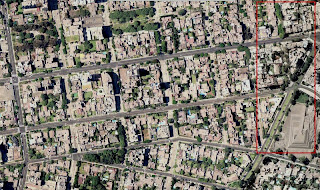A 17-year-old man was admitted to our clinic complaining about intermittent cramping abdominal pain and postprandial nausea of several months' duration. He reported that the pain was worse when supine, especially after the meals, and was relieved in the upright position. He mentioned no previous abdominal operation.
Clinical examination revealed a palpable, slightly tender mass in the epigastrium, which, however, could not be palpated when the patient stood upright. Results from an endoscopic examination of the upper gastrointestinal tract were normal. Small-bowel follow-through films taken with diatrizoate meglumine/diatrizoate sodium (Gastrografin�) showed that the jejunum occupied the upper-right part of the abdomen. Multiple jejunal loops were compressed into an ovoid mass situated behind the stomach (Fig. 1). A delay of transit in the jejunum was also documented.
In view of these findings, the patient underwent an exploratory laparotomy, during which a large right paraduodenal hernia was identified holding almost 1 metre of the jejunum. Afferent and efferent loops of jejunum could be seen entering and leaving the hernia sac. The medial border of the hernia neck consisted of the superior mesenteric and ileocolic artery; the upper and lateral borders were transverse mesocolon (Fig. 2). Exploration of the abdominal cavity revealed no other pathologic findings. The ascending and descending colon were fixated normally on the posterior abdominal wall. The jejunum was easily reduced into the peritoneal cavity and the hernia defect was closed with interrupted sutures.
The postoperative course was uneventful. The patient reported that his preoperative symptoms had not returned.
Right paraduodenal hernias account for about 25% of paraduodenal hernias, the most common type of internal hernia. (Their precise incidence is unknown, since a certain percentage remain asymptomatic throughout the person's lifetime.) These hernias are probably the result of delayed reentry of the small bowel in the abdominal cavity, leading to its entrapment under the mesentery of the ascending colon.1 There seems to be a clear male predisposition, with a ratio of about 3:1.2
Paraduodenal hernias may present with acute intestinal obstruction or intermittent postprandial epigastric pain. Their presence should be suspected without history of previous laparotomy, especially in young patients with intermittent obstructive episodes. Because the herniation of the small bowel through the hernia orifice can be intermittent, preoperative diagnosis is not always possible.3,4
Surgical repair of right paraduodenal hernias includes reduction of the protruding jejunum and closure of the hernia orifice. Large defects of the mesentery may be covered with use of a mesh.
[Reference]
References
1. Andrews E. Duodenal hernia-a misnomer. Surg Gynecol Obstet 1923;37:847-52.
2. Berardi RS. Paraduodenal hernias. Surg Gynecol Obstet 1981;152:99-110.
3. Dritsas ER, Ruiz OR, Kennedy GM, Blackford J, Hasl D. Paraduodenal hernia: a report of two cases. Am Surg 2001;67:733-5.
4. Yoo HY, Mcrgclas J, Seibert DG. Paraduodenal hernia: a treatable cause of upper gastrointestinal tract symptoms. J Clin Gastroenterol 2000;31:226-9.
Competing interests: None declared.
[Author Affiliation]
Submitted by Basilios Papaziogas, MD, Anastasio Souparis, MD, John Makris, MD, Athanasios Alexandrakis, MD, and Thomas Papaziogas, MD, PhD, of the 2nd Surgical Clinic, Aristoteles University of Thessaloniki, Thessaloniki, Greece
Correspondence to: Dr. Basilios Papaziogas, Bl. Fanariou str. 16, 551 33 Thessaloniki, Greece; fax 0030 310-992563; papaziog@med.auth.gr
Submissions to Surgical Images, soft-tissue section, should be sent to the section editors: Dr. David P. Girvan, Victoria Hospital Corporation, PO Box 5375, Station B, London ON N6A 5A5 or Dr. Nis Schmidt, Department of Surgery, St. Paul's Hospital, 1081 Burrard St., Vancouver BC V6Z 1Y6.

Комментариев нет:
Отправить комментарий